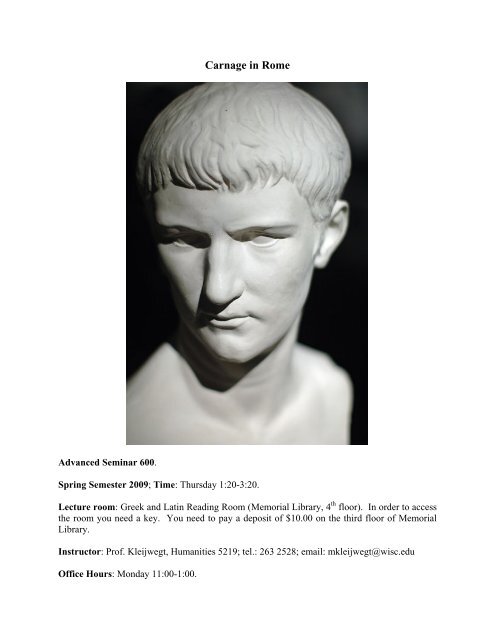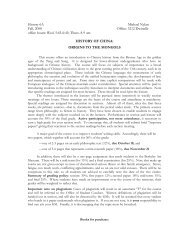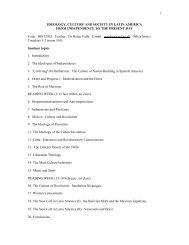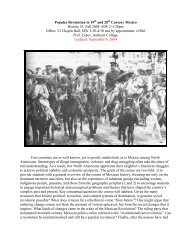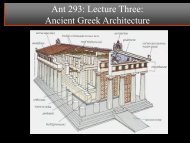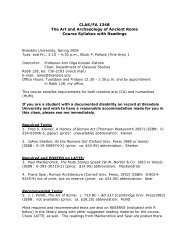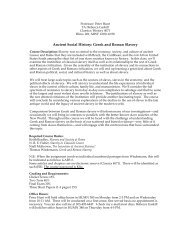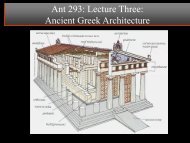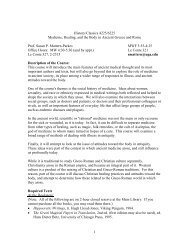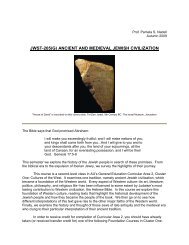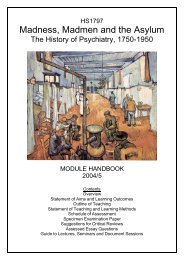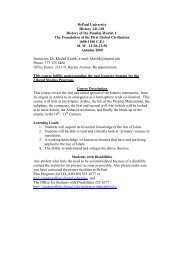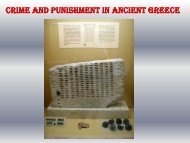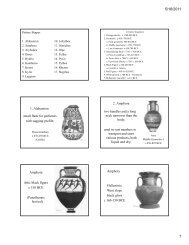Carnage in Rome
Carnage in Rome
Carnage in Rome
Create successful ePaper yourself
Turn your PDF publications into a flip-book with our unique Google optimized e-Paper software.
Course AimsThis course is designed as an <strong>in</strong>tensive read<strong>in</strong>g, discussion, research, and writ<strong>in</strong>g experience foradvanced undergraduates who major <strong>in</strong> History. Students are expected to read and be able todiscuss the secondary literature for each sem<strong>in</strong>ar. This means that students should read carefully,tak<strong>in</strong>g extensive notes. Before each sem<strong>in</strong>ar, students are encouraged to review their notes andprepare a list of questions and discussion topics they wish to raise dur<strong>in</strong>g the class meet<strong>in</strong>g.Students are expected to f<strong>in</strong>d additional material by us<strong>in</strong>g reference works, bibliographies, and<strong>in</strong>ternet search tools.Students are expected to write a polished orig<strong>in</strong>al research paper for this course. The details of thisassignment are discussed below. The student research paper will focus on a specific and narrowlydef<strong>in</strong>ed topic, but it must also reflect on some of the larger themes raised <strong>in</strong> class read<strong>in</strong>gs anddiscussions. Students will consult <strong>in</strong>dividually with the <strong>in</strong>structor as they formulate their researchtopics, collect sources, draft their papers, and revise their work for f<strong>in</strong>al submission. The length ofthe research paper is between 15 and 20 pages.Please note that your research should be based on primary sources (<strong>in</strong> translation)and secondary pr<strong>in</strong>ted works only. Internet sources such as Wikipedia etc. can notbe deemed scholarly resources and are therefore unacceptable for the paper. Ofcourse, you may use the <strong>in</strong>ternet as a search tool, but <strong>in</strong> your essay you shouldalways refer to the pr<strong>in</strong>ted primary sources and secondary literature.Class ParticipationClass discussions are a central part of this course. Students are expected to attend every sem<strong>in</strong>ar.Not attend<strong>in</strong>g meet<strong>in</strong>gs will only be allowed for serious medical, personal or other circumstancesand should be reported to the <strong>in</strong>structor by email, preferably before the sem<strong>in</strong>ar is meet<strong>in</strong>g.Students should complete all of the assigned read<strong>in</strong>g before each sem<strong>in</strong>ar meet<strong>in</strong>g, and arriveprepared for a detailed and critical discussion. Sem<strong>in</strong>ars are designed to exchange op<strong>in</strong>ions on the
ead<strong>in</strong>g, analyze important historical questions, and compare various viewpo<strong>in</strong>ts. The quality ofeach student’s class participation dur<strong>in</strong>g the semester will comprise 10 % of his/her grade.ExercisesStudents will do three exercises for this course. These exercises aim to improve students’ criticaland analytical skills. The exercises will be done <strong>in</strong> class and will be handed <strong>in</strong> to the <strong>in</strong>structor at theend of class. Performance <strong>in</strong> these exercises will count for 30% towards the f<strong>in</strong>al grade for thecourse. The read<strong>in</strong>g material for the exercises will be distributed to students ahead of time.Research Paper ProposalOn March 5 students should submit a 2 page research paper proposal <strong>in</strong> class. The research paperproposal should <strong>in</strong>clude the follow<strong>in</strong>g:A statement of the ma<strong>in</strong> research question; A statement of the hypotheses and arguments that thestudent will make <strong>in</strong> the paper; An explanation of how these hypotheses and arguments reviseexist<strong>in</strong>g <strong>in</strong>terpretations; An explanation of the strengths and shortcom<strong>in</strong>gs <strong>in</strong> the available sources.The research paper proposals should reflect careful and polished writ<strong>in</strong>g. Proofread your proposalsbefore submission! Avoid passive voice, clichés, and awkward phrases. Check your grammarcarefully. Make sure that each paragraph has a topic sentence. Each sentence should contribute tothe po<strong>in</strong>t of the paragraph where it is situated. The research paper proposal will count for 10% ofeach student’s grade.Draft of the Research PaperOn April 23 each student should submit a completed 5-10 page draft of his/her research paper <strong>in</strong>class. These drafts should not be “rough.” They should <strong>in</strong>clude polished prose, carefulargumentation, clear organization, a creative <strong>in</strong>troduction, a thoughtful conclusion, completedfootnotes, and a full bibliography.
Teach<strong>in</strong>g ProgramThursday 1/22Week 1: Introduction to the Pr<strong>in</strong>cipate and the Julio-Claudian dynasty.Thursday 1/29Week 2: The sources for the reign of Caligula.Philo; Flavius Josephus; Suetonius; Tacitus; Dio Cassius.Thursday 2/5Week 3: Exercise 1: Tacitus, The Annals of Imperial <strong>Rome</strong>, 1.6-1.8; 1.12-1-14 (pp. 34-36; 39-41).Thursday 2/12Week 4: Welcome to the imperial family.Read<strong>in</strong>g: Anthony A. Barrett, Caligula: The Corruption of Power, pp. 1-17.Suetonius, Life of Caligula, 1-13.Thursday 2/19Week 5: The first months <strong>in</strong> power.Read<strong>in</strong>g: Anthony A. Barrett, Caligula: The Corruption of Power, pp. 50-73.Suetonius, Life of Caligula, 13-17; Dio Cassius, Roman History 59.1-9.Thursday 2/26Week 6: A monster is born.Read<strong>in</strong>g: Anthony A. Barrett, Caligula: The Corruption of Power, pp. 73-91.Thursday 3/5Week 7: Conspiracy.Read<strong>in</strong>g: Anthony A. Barrett, Caligula: The Corruption of Power, pp. 91-115.Dio Cassius, Roman History 59.22-24.
Thursday 3/12Week 8: Exercise 2: Try<strong>in</strong>g to make sense of Caligula.Read<strong>in</strong>gs:P. J. Bicknell, ‘Gaius and the sea-shells’, Acta Classica 5 (1962), 72-74.J. G. F. H<strong>in</strong>d, ‘Caligula and the spoils of the ocean: a rush <strong>in</strong> the far North-West?’, Britannia 34(2003), 272-4 (electronic publication).S. J. V. Malloch, ‘Gaius on the Channel coast’, Classical Quarterly 51 (2001), 551-6 (electronicpublication).David Woods, ‘Caligula’s sea-shells’, Greece & <strong>Rome</strong> 47 (2000), 80-7 (electronic publication).Thursday 3/19Spr<strong>in</strong>g Break: no classes.Thursday 3/26Week 9: Exercise 3: Read<strong>in</strong>g secondary literature for argument.Read<strong>in</strong>g:Zvi Yavetz, ‘Caligula, Imperial Madness and Modern Historiography’, Klio 78 (1996), 105-29.Thursday 4/2Week 10: Div<strong>in</strong>e Honors.Read<strong>in</strong>g: Anthony A. Barrett, Caligula: The Corruption of Power, pp. 140-54.Thursday 4/9Week 11: Assass<strong>in</strong>ation.Read<strong>in</strong>g: Anthony A. Barrett, Caligula: The Corruption of Power, pp. 154-172.Suetonius, Life of Caligula, 56-60.Thursday 4/16Week 12: Caligula and the Jews.Read<strong>in</strong>g: Anthony A. Barrett, Caligula: The Corruption of Power, pp. 182-192.
Thursday 4/23Week 13: Evaluat<strong>in</strong>g Caligula.Read<strong>in</strong>g: Anthony A. Barrett, Caligula: The Corruption of Power, pp. 213-241.Thursday 4/30Week 14: No class. Instructor is available for one-on-one conferenc<strong>in</strong>g.Thursday 5/7Week 15: No class. Instructor is available for one-on-one conferenc<strong>in</strong>g.
Bibliography CaligulaPrimary Sources and Commentaries:Flavius Josephus, Jewish Antiquities, Books 18 and 19 (DS116 J7 1926 9).T. P. Wiseman, Death of an emperor, translation and commentary by T.P. Wiseman, Exeter1991 (DG283 J57 1991).Philo, Legatio ad Gaium (Embassy to the emperor Gaius), edited with an <strong>in</strong>troduction,translation and commentary by E. Mary Smallwood, Leiden 1970 (DS135 E4 P483 1970).Suetonius, Life of Caligula, <strong>in</strong> Suetonius, The Twelve Caesars, transl. by Robert Graves and withan <strong>in</strong>troduction by Michael Grant, Harmondsworth 2000 (DG277 S7 T5 2000).Donna W. Hurley, An Historical and Historiographical Commentary on Suetonius’ Life of C.Caligula, Atlanta 1993 (DG283 S83 H87 1993).David Wardle, Suetonius’ Life of Caligula: a commentary, Brussels 1994 (PA25 C62 v.225).Tacitus, The Annals of Imperial <strong>Rome</strong>, <strong>in</strong>troduction and translation by Michael Grant,Harmondsworth 1996 (DG207 T3 G7 1996).E. Mary Smallwood, Documents illustrat<strong>in</strong>g the pr<strong>in</strong>cipates of Gaius, Claudius and Nero,London/Cambridge 1967 (DG281 S6).General Histories:Alan K. Bowman, Edward Champl<strong>in</strong>, and Andrew L<strong>in</strong>tott (eds.), Cambridge Ancient History,vol. X: The Augustan Empire, 43 BC-AD 69, Cambridge 1996, pp. 70-147; 198-229; 737-782.Chester G. Starr, A History of the Ancient World, New York and Oxford 1991 (D59 S75 1991).H. H. Scullard, From the Gracchi to Nero: a history of <strong>Rome</strong> from 133 BC to AD 68, New Yorkand London 1982 (DG254 S35 1982).Monographs:J. P. V. D. Balsdon, The Emperor Gaius, Oxford 1934 (DG283 B3).A. A. Barrett, Caligula: The Corruption of Power, New Haven 1989 (DG283 B37 1990).
A. Ferrill, Caligula, Emperor of <strong>Rome</strong>, London 1991 (DG283 F47 1991).Articles:Jane Bellemore, ‘Gaius the pantomime’, Antichthon 28 (1994), 65-79.Thomas D. Benediktson, ‘Caligula’s madness. Madness or <strong>in</strong>terictal temporal lobe epilepsy?’,Classical World 82 (1988-1989), 370-375 (electronic publication – JSTOR).Thomas D. Benediktson, ‘Caligula’s phobias and philias: fear of seizure’, Classical Journal 87(1991-1992), 159-163 (electronic publication – JSTOR).P. J. Bicknell, ‘Gaius and the sea-shells’, Acta Classica 5 (1962), 72-74.P. Bilde, ‘The Roman emperor Gaius (Caligula)’s attempt to erect his statue <strong>in</strong> the temple ofJerusalem’, Scand<strong>in</strong>avian Journal of Theology 32 (1978), 67-93.G. W. Clarke, ‘Seneca the Younger under Caligula’, Latomus 24 (1965), 62-69.Duncan Fishwick, ‘A duck<strong>in</strong>g <strong>in</strong> the Tiber (Dio 61[60], 33, 8)’, American Journal of AncientHistory 12 (1987), 73-76.Duncan Fishwick and B. D. Shaw, ‘Ptolemy of Mauretania and the conspiracy of Gaetulicus’,Historia 25 (1976), 491-494 (electronic publication – JSTOR).Marleen Boudry Flory, ‘Caligula’s Inverecundia: a note on Dio Cassius 59.12.1’, Hermes 114(1986), 365-71 (electronic publication – JSTOR).Thomas E. Goud, ‘The Sources of Josephus Antiquities 19’, Historia 45 (1996), 472-82(electronic publication – JSTOR).J. G. F. H<strong>in</strong>d, ‘Caligula and the Spoils of the Ocean: a Rush <strong>in</strong> the far North-West?’, Britannia34 (2003), 272-4 (electronic publication – JSTOR).Donna W. Hurley, ‘Gaius Caligula <strong>in</strong> the Germanicus tradition’, American Journal of Philology110 (1989), 316-338 (electronic publication – JSTOR).M. Kajava, ‘The name of Cornelia Orest<strong>in</strong>a/Orestilla’, Arctos 18 (1984), 23-30.A. Jakobson and H. M. Cotton, ‘Caligula’s recusatio imperii’, Historia 34 (1985), 497-503(electronic publication – JSTOR).R. S. Katz, ‘The illness of Caligula’, Classical World 65 (1972), 223-225 (electronic publication– JSTOR).R. S. Katz, ‘Caligula’s illness aga<strong>in</strong>’, Classical World 70 (1977), 451 (electronic publication –JSTOR).
B. J. Kavanagh, ‘The conspirator Aemilius Regulus and Seneca’s aunt’s family’, Historia 50(2001), 379-384 (electronic publication – JSTOR).B. J. Kavanagh, ‘Asiaticus, Seneca and Caligula’s Assass<strong>in</strong>ation’, <strong>in</strong> Mark Joyal (ed.), In altum:Seventy-five years of classical studies <strong>in</strong> Newfoundland, St. John’s 2001, 105-17.Arthur Keaveney and John A. Madden, ‘The crimen maiestatis under Caligula: the evidence ofDio Cassius’, Classical Quarterly 48 (1998), 316-320 (electronic publication – JSTOR).Allen Kerkeslager, ’Agrippa and the mourn<strong>in</strong>g rites for Drusilla <strong>in</strong> Alexandria’, Journal for theStudy of Judaism 37 (2006), 367-400.M. Kleijwegt, ‘Caligula’s “Triumph” at Baiae’, Mnemosyne 47 (1994), 652-71 (electronicpublication – JSTOR).M. Kleijwegt, ‘Caligula as Auctioneer’, Acta Classica 39 (1996), 55-66.Hugh L<strong>in</strong>dsay, ‘Revenge on the Tyrant: the assass<strong>in</strong>ation of Phillip II and Caligula’, Eranos 92(1994), 73-84.S. J. V. Malloch, ‘Gaius’ Bridge at Baiae and Alexander-imitatio’, Classical Quarterly 51(2001), 206-17 (electronic publication – JSTOR).S. J. V. Malloch, ‘Gaius on the Channel Coast’, Classical Quarterly 51 (2001), 551-6 (electronicpublication – JSTOR).S. J. V. Malloch, ‘The Death of Ptolemy of Mauretania’, Historia 53 (2004), 38-45 (electronicpublication – JSTOR).V. Massaro and I. Montgomery, ‘Gaius – Mad, Bad, Ill, or all three?’, Latomus 37 (1978), 894-909.V. Massaro and I. Montgomery, ‘Gaius (Caligula) doth murder sleep’, Latomus 38 (1979), 699-700.W. C. McDermott, ‘Suetonius, Caligula, 50, 3’, Latomus 31 (1972), 527.Thomas McG<strong>in</strong>n, ‘Caligula’s Brothel on the Palat<strong>in</strong>e’, Echos du Monde Classique/ClassicalViews 17 (1998), 95-107.M. G. Morgan, ‘Caligula’s illness aga<strong>in</strong>’, Classical World 66 (1973), 327-329 (electronicpublication - JSTOR).M. G. Morgan, ‘Once aga<strong>in</strong> Caligula’s illness’, Classical World 70 (1977), 452-453 (electronicpublication - JSTOR).David Noy, ‘A sight unfit to see: Jewish reactions to the Roman imperial cult’, Classics Ireland8 (2001), 68-83 (electronic publication – F<strong>in</strong>d it).James H. Oliver, ‘Lollia Paul<strong>in</strong>a, Memmius Regulus and Caligula’, Hesperia 35 (1966), 150-3(electronic publication – JSTOR).
Frank Shaw, ‘The emperor Gaius’ employment of the div<strong>in</strong>e name’, The Studia PhilonicaAnnual 17 (2005), 33-48.C. J. Simpson, ‘The Cult of the Emperor Gaius’, Latomus 40 (1981), 489-511.C. J. Simpson, ‘The ‘Conspiracy’ of AD 39’, <strong>in</strong> C. Deroux (ed.), Studies <strong>in</strong> Lat<strong>in</strong> Literature andRoman History, vol. 2, Brussels 1980, 347-66.C. J. Simpson, ‘Caligula’s Cult. Imitatio Augusti’, Revue Belge de philologie et d’histoire 75(1997), 107-112.N. H. Taylor, ‘Popular opposition to Caligula <strong>in</strong> Jewish Palest<strong>in</strong>e’, Journal for the Study ofJudaism 32 (2001), 54-70 (electronic publication – F<strong>in</strong>d it).G. B. Townend, ‘The sources of the Greek <strong>in</strong> Suetonius’, Hermes 88 (1960), 98-120 (electronicpublication – JSTOR).D. Wardle, ‘When did Caligula die?’, Acta Classica 34 (1991), 158-165.D. Wardle, ‘Cluvius Rufus and Suetonius’, Hermes 120 (1992), 466-482 (electronic publication– JSTOR).D. Wardle, ‘Caligula and the client k<strong>in</strong>gs’, Classical Quarterly 42 (1992), 437-43 (electronicpublication – JSTOR).D. Wardle, ‘Caligula and his wives’, Latomus 57 (1998), 109-26.D. Wardle, ‘The Bald and the Beautiful: imperial hair-envy and the end of Ptolemy ofMauretania?’, Arctos 40 (2006), 175-88.D. Wardle, ‘Caligula’s bridge of boats – AD 39 or 40?’, Historia 56 (2007), 118-20.Susan Wood, ‘Diva Drusilla Panthea and the Sisters of Caligula’, American Journal ofArachaeology 99 (1995), 457-82 (electronic publication – JSTOR).David Woods, ‘Caligula’s Seashells’, Greece & <strong>Rome</strong> 47 (2000), 80-7 (electronic publication –JSTOR).David Woods, ‘Did Caligula plan to bridge the English Channel?’, Ancient World 33 (2002),157-169.David Woods, ‘Caligula, Ptolemy of Mauretania, and the danger of long hair’, Arctos 39 (2005),207-14.David Woods, ‘Tiberius on Caligula the snake and other contextual problems’, Arctos 41 (2007),117-27.David Woods, ‘Caligula’s Gallic captives’, Latomus 66 (2007), 900-4.
David Woods, ‘Conceal<strong>in</strong>g Caligula’s Epilepsy’, <strong>in</strong> C. Deroux (ed.), Studies <strong>in</strong> Lat<strong>in</strong> Literatureand Roman History, vol. XIV, Brussels 2008, 306-12.Yange Wu and Victoria A. Russell, ‘Philo, On the embassy 80: Caligula dress<strong>in</strong>g as heroes’,Journal of Ancient Civilization 15 (2000), 69-78.Zvi Yavetz, ‘Caligula, Imperial Madness and Modern Historiography’, Klio 78 (1996), 105-29.


